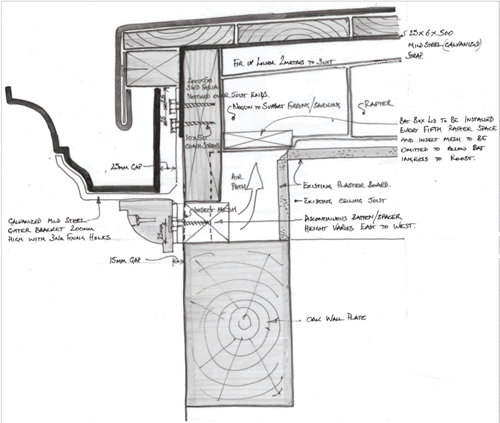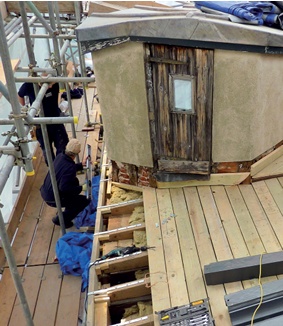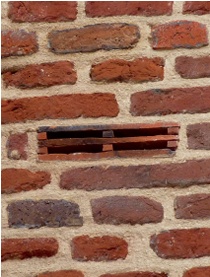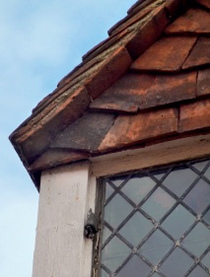The Management of Bats in Churches
Andrew Harris
 |
| Brown long-eared bats roosting in a roof void: this species typically roosts in small colonies in older buildings, barns and tree holes (Photo: Hugh Clark) |
The presence of bats is one of the most challenging issues that custodians of church buildings can face. The impact that even a small colony of bats can have on church fabric, coupled with the high level of protection enshrined in environmental legislation, can leave custodians feeling quite helpless when considering ways to manage the situation.
For conservation architects and surveyors a bat roost is one of those issues, like asbestos, that can stop a building project dead in its tracks. However, it need not be so. There are a number of different methods for dealing with bats in churches and a recent report completed for the Department for Environment, Food & Rural Affairs (Defra) by the University of Bristol (see recommended reading) has suggested new management techniques. Ultimately, bats need not stop or disadvantage a conservation or restoration project: it is usually just a question of bringing in the right expertise at the right time.
Bats have colonised buildings for as long as buildings have existed. A 600-year-old church, for example, may have been re-roofed many times in its life without this invasive work or (until relatively recently) the lack of legislative protection, preventing bats from coexisting with the building. Although bat populations have been harmed by pesticides and urban lighting, and the sites where they seek shelter are now more important than ever, it seems that the present legislation is focussed more on the symptoms than on the original cause of bat decline. Nevertheless, one of the many duties of a conservation architect is to find a balance that accommodates the needs of the building and its users, whether human or protected species, within the framework of the current legislation.
 |
|
| Technical drawing of a bat hotel at the Canons’ Cloister, St George’s Chapel, Windsor Castle and, below left, construction in progress before the roof decking was re-laid |
Bat colonisation in historic churches does bring benefits. Bats help to control insect populations and they prey on wood-boring insects such as deathwatch beetle and common furniture beetle in the flying, adult phase of the insects’ life cycle. Bats also contribute to habitat biodiversity and some churches have developed educational and community outreach activities such as nature walks or evening bat watches to explore church and churchyard habitats.
However, many church custodians would consider these benefits to be outweighed by the harmful impact of colonisation. Where bats can roost and fly inside church buildings, their droppings and urine can cause serious damage to furnishings and fittings – a particularly severe problem for those churches which house historic artefacts. A phobia of bats can deter people from using church buildings and, in the worst colonisation cases, the presence of bats can restrict the use of a church for worship or other purposes.
The University of Bristol’s report found that approximately 60 per cent of pre-16th-century churches contain bat roosts. Taking into account more recent buildings, this means that many churches will need to consider the issues associated with roosting bats at some point, although it should be stressed that large colonies are only found in churches relatively rarely.
Bats are a European protected species and, as such, are strictly protected under EU and UK law due to concerns over their declining populations. In England and Wales, the relevant legislation is the Wildlife and Countryside Act 1981, the Countryside and Rights of Way Act 2000, the Natural Environment and Rural Communities Act 2006, and the Conservation of Habitats and Species Regulations 2010.
In summary, it is a criminal offence to damage, disturb or destroy any bat roost, obstruct access to a bat roost, or deliberately capture, kill or injure a bat. This legislation also obliges competent authorities, including diocesan advisory committees and consistory courts, to take bats adequately into account when works such as building restoration have the potential to damage roosts or disturb bats.
Where conflict can arise between human activity and bats, Defra can authorise statutory nature conservation organisations to grant licenses for management and mitigation activities to resolve the conflict. This licensing system is complex and time-consuming, but nevertheless offers hope to building custodians who are looking for a responsible solution that balances ongoing building use, the protection of historic or culturally significant fabric, and the future management of bat colonisation.
The aim of the University of Bristol research project was to examine the impact of current licensable activities and investigate new mitigation activities that could be used to reduce conflict between humans and bats while maintaining the conservation status of bats.
 |
The research focussed on two major areas of conflict: situations where large maternity roosts exist in a domestic setting, and churches. This article focusses on the second aspect of the report. The research team conducted extensive research across a series of church buildings in Norfolk, and in particular examined whether acoustic or light deterrents were effective in encouraging bats to move away from sensitive areas of churches where conflict with human activity or the presence of important artefacts was considered greatest.
The findings regarding acoustic deterrence were particularly interesting and useful. Speakers emitting continuous broadband ultrasound were carefully positioned so as to deter bats from entering particular parts of each building. The study found that the observed response of bats to the presence of an acoustic deterrent was strong. Within a matter of days, most bats had either moved to alternative roosts within the church or had found roosts outside the church.
Importantly from a species conservation point of view, the presence of an acoustic deterrent did not affect the home ranges, habitat preferences or nocturnal behaviour of foraging bats. The report suggests that a prototype acoustic deterrent, developed during the project as a practical and affordable option that could be licensed for use by churches in the future, was effective at deterring many bats from roosts but will benefit from further development to improve long-term performance.
The use of lighting deterrence was much less encouraging. While the costs involved for lighting are lower than for acoustic deterrence, the impact on the welfare of bat populations can be severe because lighting can have a detrimental effect on the emergence and foraging time of bats. Care needs to be taken when positioning lighting as lights shone at roosts can have the effect of entombing bats, and evidence suggests that sustained use of lights in this way may result in the deaths of many bats. Owing to welfare concerns, one of the studies was terminated early and the report authors concluded that the use of lighting to manage bats in churches has the potential to cause serious harm and should be strictly regulated.
While it can help to deter vandals and lead thieves, the sustained use of nocturnal lighting in churches is also potentially expensive, increases the church’s carbon footprint and can have a negative aesthetic impact. Lighting distorts the foraging opportunities available for bats and this may even encourage them to prefer specific locations and deter them from roosting in others.
The research project looked to a limited degree at the provision of artificial roosts to encourage bats to move away from sensitive areas in churches. It is here that the report is perhaps disappointing, as this area of work is touched upon only lightly. The report states that bats were not observed using alternative roosts during the relatively short experimental periods (although some limited use was observed subsequently), and that the adoption of bat boxes is dependent upon many factors and may take several months or years.
 |
| A tile slip bat access vent |
 |
| Hanging clay tiles above a dormer window at Hampton Court Palace were discreetly raised in one corner to allow bats to access the roof space. |
The provision of alternative accommodation for bats is an effective way of managing bat colonisation, and it is to be hoped that Defra will consider further research in this area to identify possible solutions for building custodians.
From the conservation professional’s perspective, perhaps the best approach to coping with bats in a historic building is simply to follow the principles that underlie all sound conservation: work with the existing building and traditional materials to see what measures are possible before considering more invasive or architecturally inauthentic techniques.
Traditional handmade clay tiles, for example, are a far more suitable alternative to machine-produced tiles as they contain enough dimensional variation to accommodate bats within the outer roof layer without damaging the internal fabric. On older buildings, putlog holes (small holes in external walls to support the original timber scaffolding) create a void for bats and repointing work can retain a small gap for bats to continue accessing a roosting space within the external fabric.
Martin Ashley Architects has used this and similar techniques successfully on church buildings and elsewhere, including at Hampton Court Palace where tile slip vents (above right) can be used to provide roosting opportunities.
Eaves and soffits provide attractive bat roosting spaces, and insect mesh can be fitted slightly further back in the building envelope to prevent them from accessing further into the building while allowing ventilation. At Kew Palace Kitchens, ventilating details were specially designed to allow bats to roost within the external fabric while protecting the building interior, a technique that is readily adaptable to church buildings.
Efforts to provide alternative roost accommodation for bats are certainly worthwhile and greater research in this area may prove useful to custodians and conservators alike. When re-roofing the Canons’ Cloister at St George’s Chapel, Windsor Castle, for example, bats were discovered only once the building had been scaffolded and a series of soffits removed.
Work was stopped in the specific location until a series of new bat boxes had been designed and installed at intervals along the length of a new eaves section. As these were not ventilated into the roof void they remained dry and draught-free. Bats were further encouraged to inhabit these new spaces by scattering the droppings, which had been found when the soffits were removed, into the new boxes.
Other projects allow greater freedom to create ‘bespoke’ bat accommodation: at Brockham Lime Kiln in Surrey, for example, a collapsed kiln was specially rebuilt with the help of historic brick specialists to encourage bat colonisation. It was a challenging project not only to design complex brickwork but also to avoid disturbing bats present in neighbouring structures, a scenario that exists in dark and peaceful church crypts across the country. At both projects the end results were very successful, but would certainly not have been possible without the co-operation of the project teams and the valuable expertise and advice of experienced bat surveyors.
Any measures to accommodate or manage bat colonisation in churches will need to take a wide range of issues into account such as the demands of particular species, existing roosting positions, the availability or potential of alternative roosts, and roosting cycles. Getting pre-emptive surveys and accessing good specialist advice is always paramount. Based on the University of Bristol research, further research and product development are underway in the field of acoustic deterrence to address bat colonisation inside church buildings.
In addition, further work should be done to highlight how existing fabric and traditional techniques or materials can address colonisation. Bats can be accommodated, but more can be done to assist custodians in addressing the challenges that they bring. More importantly, Bristol University’s research suggests how and where the legislation could perhaps be targeted more effectively.
~~~
Recommended Reading
Bats in Churches: A Management Guide, Natural England, 2011
Bat Mitigation Guidelines, Natural England, 2004
Bat Surveys: Good Practice Guidelines, 2nd edition, Bat Conservation Trust, 2012
Bats in Traditional Buildings, English Heritage, National Trust and Natural England, 2009
K Gunnell, ‘Conserving Bats and Buildings: A Natural Synergy’, The Building Conservation Directory, Cathedral Communications Limited, Tisbury, 2012
M Zeale et al, Improving mitigation success where bats occupy houses and historic buildings, particularly churches, Defra Research Project WM0322, University of Bristol, 2014



